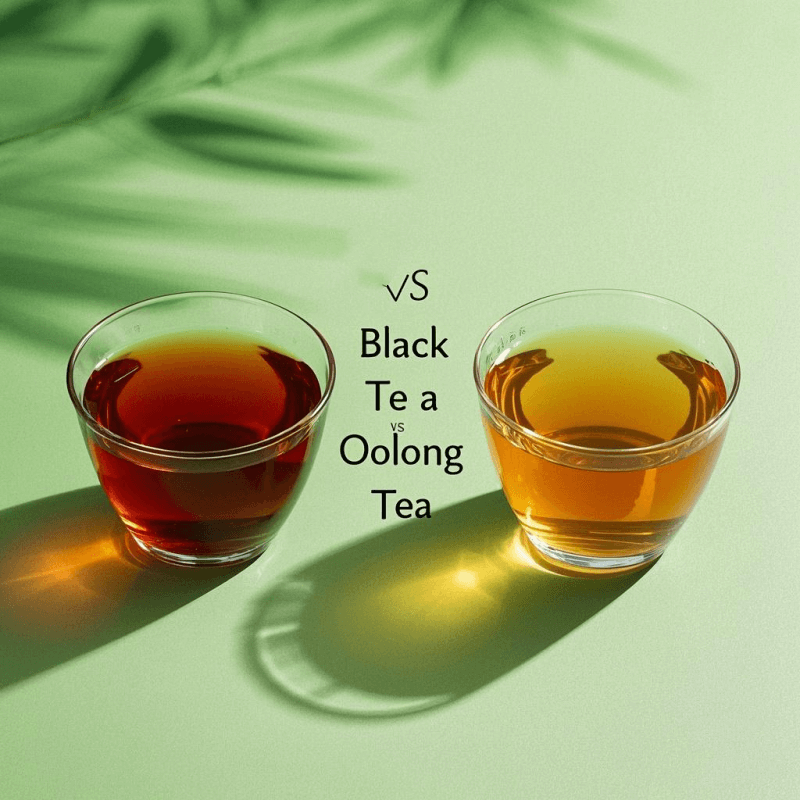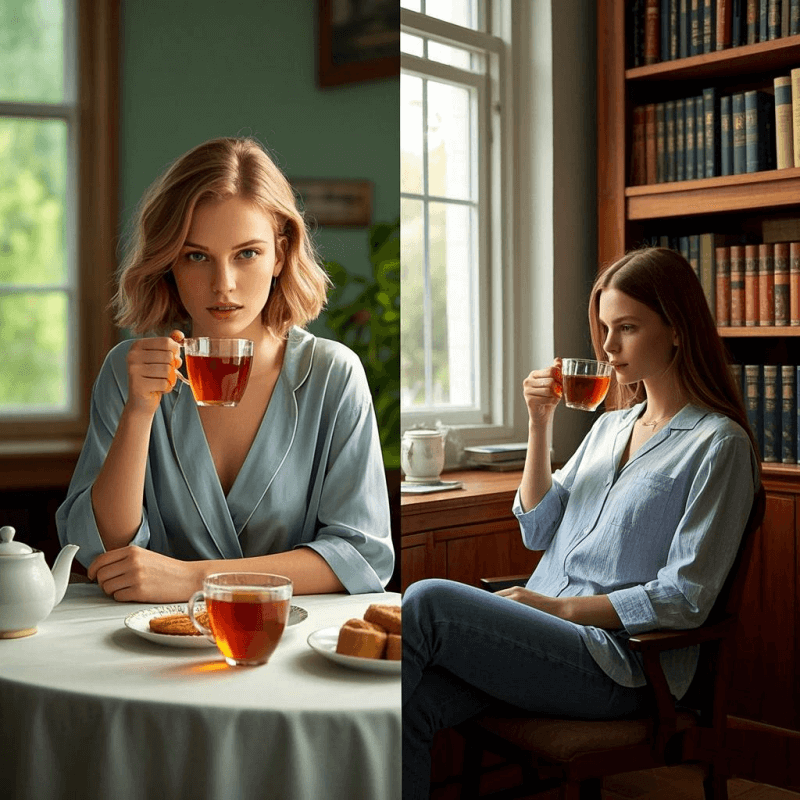
1. Introduction: Why Compare Black Tea vs Oolong Tea?
Tea lovers often debate their favorite brews, but few comparisons spark as much interest as black tea vs oolong tea. Both come from the same plant, yet their distinct flavors, aromas, and effects make them suited to different moments and moods. Understanding their differences isn’t just for enthusiasts—it helps you choose the right tea for your morning rush, afternoon slump, or wellness goals.
Whether you’re drawn to bold, robust sips or smooth, nuanced flavors, black tea vs oolong tea offers something for everyone. This guide breaks down their origins, tastes, health benefits, and more, so you can make informed choices about which brew belongs in your cup. Let’s dive into what makes these two teas unique.
2. What Is Oolong Tea and What Is Black Tea?
To appreciate black tea vs oolong tea, we first need to understand their roots. Both start as leaves from the Camellia sinensis plant, but their journeys diverge at the processing stage—specifically, oxidation, the chemical reaction that transforms leaf color and flavor.
🍃 What Is Oolong Tea?
This semi-oxidized tea falls between green and black varieties, with oxidation levels ranging from 10–80%. This middle ground gives it incredible versatility: lightly oxidized types (like Tie Guan Yin) offer floral, buttery notes, while heavily oxidized varieties (such as Da Hong Pao) lean rich and roasted. Grown primarily in China (Fujian, Guangdong) and Taiwan (Alishan, Dong Ding), this tea thrives in high-altitude, misty regions that slow growth and concentrate flavor compounds.
🍂 What Is Black Tea?
Black tea is fully oxidized (80–100%), a process that turns leaves dark brown or black and develops bold, malty flavors. Originating in China but now grown globally (India’s Assam, Sri Lanka’s Ceylon), it undergoes rolling and full oxidation, which breaks down catechins (antioxidants) into theaflavins and thearubigins—compounds responsible for its robust taste. Popular types include Darjeeling, Earl Grey, and English Breakfast.
This difference in oxidation is the foundation of black tea vs oolong tea—shaping everything from their appearance to their effects on the body.
3. Flavor Differences: How Black Tea vs Oolong Tea Taste
The most noticeable contrast in black tea vs oolong tea lies in their flavor profiles, directly influenced by oxidation and processing.
👅 Black Tea Flavors
Black tea’s full oxidation creates bold, pronounced tastes:
- Base Notes: Malty, earthy, or slightly bitter, with astringency that dries the palate (think of strong breakfast teas).
- Variety Highlights:
- Assam: Rich, malty, with hints of caramel.
- Darjeeling: Floral, fruity (often compared to muscat grapes), with bright acidity.
- Earl Grey: Bergamot citrus brightness layered over a black tea base.
- Aroma: Roasty, woody, or spicy, with a strong, immediate scent that fills the room when brewed.
👅 Oolong Tea Flavors
The semi-oxidized brew’s flavor range spans from light and fresh to deep and complex:
- Base Notes: Buttery, floral, or nutty, with a smooth, umami-rich finish that lingers.
- Variety Highlights:
- Tie Guan Yin: Orchid-like florals with a creamy, sweet aftertaste.
- Da Hong Pao: Dark chocolate, stone fruit, and mineral “mountain rhyme” from Wuyi Mountains.
- Alishan: Milky, peach-forward sweetness with a delicate green hue.
- Aroma: Floral, fruity, or roasted, depending on oxidation—often more subtle than black tea but equally inviting.
In black tea vs oolong tea, black tea leans bold and straightforward, while the semi-oxidized option rewards slow sipping with evolving flavors.
4. Health Benefits of Black Tea vs Oolong Tea

Both teas offer impressive health benefits, but their unique compounds mean they shine in different areas. Let’s compare the science-backed perks of black tea vs oolong tea.
🌿 Black Tea Benefits
- Heart Health: Rich in theaflavins and thearubigins, black tea may lower LDL (“bad” cholesterol) and reduce heart disease risk, according to a study in The American Journal of Clinical Nutrition.
- Energy Boost: With 40–70mg of caffeine per 8oz cup, it provides a stronger pick-me-up than its semi-oxidized counterpart, making it ideal for mornings.
- Gut Health: Contains prebiotics that feed beneficial gut bacteria, supporting digestion, as noted by Healthline.
🌿 Oolong Tea Benefits
- Metabolic Support: Its mix of catechins and caffeine may enhance fat oxidation. A 2011 study in The Journal of Nutrition found daily intake increased calorie burn by 10–12%.
- Blood Sugar Regulation: Polyphenols in the tea help stabilize post-meal glucose spikes, making it a smart choice for managing energy levels, per WebMD.
- Stress Relief: L-theanine, an amino acid abundant in the brew, promotes calm focus by balancing caffeine’s effects—great for busy afternoons.
In black tea vs oolong tea, black tea excels at energy and heart support, while the semi-oxidized variety shines for metabolism and steady energy.
5. Caffeine Content and Brewing Methods Compared
Caffeine levels and brewing techniques further set black tea vs oolong tea apart, affecting both taste and experience.
☕ Caffeine Content
- Black Tea: Typically contains 40–70mg of caffeine per 8oz cup, depending on steeping time and leaf quality. Stronger brews (like English Breakfast) lean toward the higher end.
- Oolong Tea: Has 30–50mg of caffeine per 8oz cup, with lighter oxidized varieties (e.g., Alishan) often lower than darker ones (e.g., roasted Tie Guan Yin).
This makes black tea better for a robust morning jolt, while the semi-oxidized option offers a gentler lift—ideal for avoiding afternoon crashes.
🔥 Brewing Methods
- Black Tea:
- Water temperature: 200–212°F (93–100°C) to extract bold flavors.
- Steep time: 3–5 minutes (over-steeping can make it bitter).
- Ratio: 1 teaspoon of leaves per 8oz water.
- Oolong Tea:
- Water temperature: 185–205°F (85–96°C) (lower for light varieties, higher for dark).
- Steep time: 1–3 minutes for first steep; 30 seconds longer for subsequent infusions (it can steep 5–8 times!).
- Ratio: 1–2 teaspoons per 8oz water (more leaves for multiple steepings).
Brew oolong tea traditionally with our artisanal tools to master its nuanced steeping—clay teapots enhance its flavor beautifully.
6. Which Tea Fits Your Lifestyle and Wellness Goals?
Choosing between black tea vs oolong tea depends on your daily routine, taste preferences, and health priorities. Here’s how to decide:
🕒 Morning Routine
- Pick black tea if you need a strong, immediate energy boost to start your day—its higher caffeine pairs well with breakfast foods like toast or eggs.
- Choose the semi-oxidized brew if you prefer steady energy without jitters. Its smooth, buttery flavor complements light mornings (try it with pastries or fruit).
🏃 Active Lifestyles
- Black tea’s caffeine and heart-supporting compounds make it great for pre-workout energy.
- The semi-oxidized variety’s metabolic benefits and hydration support recovery—sip it post-workout to replenish.
🧘 Relaxation Time
- Black tea’s boldness works for cozy evenings with cookies or chocolate, but avoid it 4–6 hours before bed to prevent sleep disruptions.
- The semi-oxidized tea’s L-theanine promotes calm, making it perfect for evening unwinding (opt for lightly oxidized types for lower caffeine).
🍽️ Food Pairings
- Black tea pairs with rich, savory foods (grilled meats, spicy dishes) and sweet treats (biscuits, cake).
- The semi-oxidized brew complements delicate flavors: dim sum, light pastries, or fresh fruit.
Discover premium oolong tea that suits your lifestyle—whether you need morning focus or evening relaxation.
7. Conclusion: Black Tea vs Oolong Tea—Your Best Pick
In the debate of black tea vs oolong tea, there’s no “winner”—only what works for you. Black tea offers bold flavor, high energy, and heart benefits, making it a classic choice for busy mornings and robust palates. The semi-oxidized brew, with its versatile flavors, metabolism support, and gentle caffeine, shines for slow sipping, multiple steepings, and steady energy throughout the day.
Both teas bring unique joys: black tea’s comforting boldness, the semi-oxidized option’s evolving complexity. The best part? You don’t have to choose—keep both in your pantry to match your mood.
Shop our handpicked oolong tea collection online to explore its diversity, or stock up on black tea for those days when you need a bold boost. After all, the best tea is the one that fits your life.
